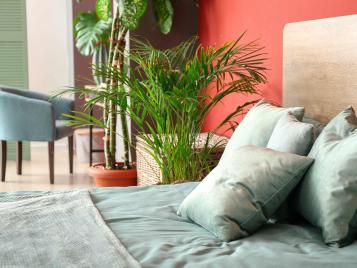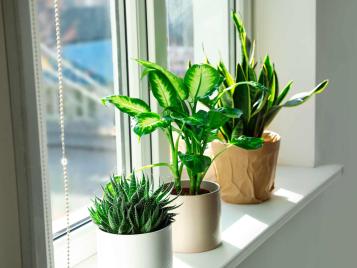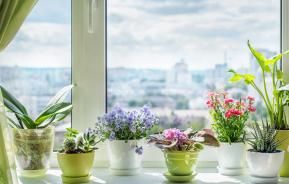Keeping your houseplants happy
How do you get the most from your plants? Well one of the ways to keeping your houseplants happy, is where you place them.
Most houseplants will have come from specific parts of the world, many from tropical regions and others from hot, dry areas. Make sure you know where your plants have come from before deciding on their permanent home. For example, cacti won’t be happy in a damp dark bathroom whilst a peace lily will not survive well on a bright sunny windowsill.
For help on finding out more about this. Read our guide on success from your houseplants!

How to not kill your houseplants
For the houseplant novice, this is a real concern, but with the right care you’ll make sure your houseplants thrive rather than wither away.
All of your houseplants have one thing in common. They all need light, but each plant will differ in the amount that they will need. Don’t just place your indoor plants without a thought. Just because that plant will fit in with the décor of a certain area of the house, does not mean it is best for your houseplant.
Think about questions like:
- Which rooms get the most sunlight in my house?
- Which direction do my windows face?
- Where are my heaters?
- What is the average temperature roughly in my house?
With that, you will start to get an idea of which areas will work best when situating your houseplants.
Types of houseplants
As stated above, your plants will need light. Some will thrive off having as much as possible, whilst others will need partial or a full cover of shade for the majority of the time.
Remember that your plants do not need direct sunlight at all possible hours of the day as this can scorch the leaves and the roots of the plant.
Most plants will be happy with a window that is either west or east facing. Try not to have too many plants facing a northerly or southerly window unless you know they like that condition.
Indoor plants that like shade
There are plants that require partial or full shade for large portions of the day.
Plants such as peace lilies, ferns and those with large dark leaves such as philodendrons do best being kept out of direct sunlight and can copy with shadier locations. This doesn’t mean that they never have access to light but they prefer being away from a bright window, especially in the summer.
Plants with large, thick, fleshy leaves – like Jade- stonecrop and zebra plant – will tend to do well in the shade for the most part.
Indoor plants for direct sun
Not all indoor plants require shade, some will thrive in full sun so feel free to place them on a sunny south facing windowsill and let them bask in the sunlight. Indoor plants that like full sun include cacti, aloe vera, Snake plant, kalanchoe and echeverias.
Plant care tips

As you are taking them out of their natural environment, houseplants may need more care. It’s always best to do a little bit of research on your plants, even if it’s to see how often your houseplants should be watered or what the desired climate for your houseplant should be.
Most houseplants are happy at around 20°C (70°F), but some only thrive at colder temperatures. For example, cyclamen prefer a temperature range between 10°C to 15°C (50°F to 60°F) and Cineraria like even colder temperatures. If you own a bonsai tree or tropical indoor plants, then you may need to have a constant temperature of around 20°C (70°F).
Be careful when placing your plants near a heat source. Most forms of home heating produce an atmosphere which is too dry for the majority of pot plants. Central heating in winter will create a warm atmosphere which is as dry as a desert. This will be almost inhospitable for indoor plants, especially those used to the jungle floor such as Monstera and epiprenums.
You can spray your plants with a mister regularly or create a micro-climate by placing the pot on a shallow tray of pebbles filled with water and standing the decorative container on top of the pebbles.
Always check to see if your houseplants need watering by pushing your finger into the soil to see if its dry or moist. You should also look to feed your house plants with a liquid plant food every 7 to 14 days from April to September.
To know more about how to care for your houseplants, sign up to our monthly newsletter and get your copy of our Essential Guide to Houseplants.
Frequently asked questions about where to place houseplants
Do indoor plants need to be by windows?
Most houseplants like to be by windows. Some thrive in sunny conditions, whilst others need more shade than direct sunlight. Most houseplants are happy with a window that is either west, or east facing.
Should you have houseplants in your bedroom?
Putting a house plant in your bedroom will not only add a touch of brightness and life to your bedroom, it can also have plenty of health benefits too. Houseplants can absorb gases through the pores in their leaves, which helps to filter and clean the air you breathe every day in your bedroom.
Can plants survive in a bathroom without a window?
This depends on the plant. If you want to add a touch of green to your bathroom but you don’t have a window, you’ll need a plant that can cope with high humidity and low light levels. Boston ferns, spider plants and devils ivy can cope with these conditions but keep an eye on them.









